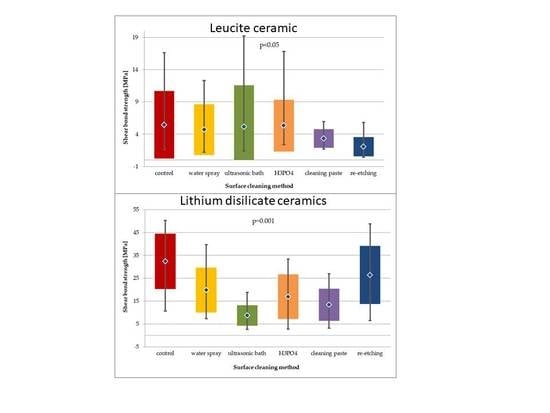Effect of Surface Cleaning Regimen on Glass Ceramic Bond Strength
Abstract
1. Introduction
2. Results
2.1. Surface Elemental Analysis
2.2. Bond Strength
3. Discussion
4. Materials and Methods
4.1. Surface Elemental Analysis
4.2. Bond Strength
4.3. Statistical Analysis
5. Conclusions
Author Contributions
Conflicts of Interest
References
- Lapinska, B.; Szynkowska, M.I.; Rogowski, J.; Nowak, J.; Sokolowski, G.; Sokolowski, J.; Lukomska-Szymanska, M. Changes in dental ceramic surface structure and their influence on the bond strength to composite material. Przem. Chem. 2017, 96, 370–374. [Google Scholar]
- Ramakrishnaiah, R.; Alkheraif, A.A.; Divakar, D.D.; Matinlinna, J.P.; Vallittu, P.K. The effect of hydrofluoric acid etching duration on the surface micromorphology, roughness, and wettability of dental ceramics. Int. J. Mol. Sci. 2016, 17, 822. [Google Scholar] [CrossRef] [PubMed]
- Lapinska, B.; Malgorzata, S.I.; Sokolowski, J.; Bociong, K.; Lukomska-Szymanska, M. Evaluation of shear bond strength of composite resin to lithium disilicate ceramic using different ceramic surface treatment methods. Inżynieria Mater. Mater. Eng. 2013, 34, 737–740. [Google Scholar]
- Lapinska, B.; Sokolowski, G.; Rzepkowski, A.; Sokolowski, J.; Lukomska-Szymanska, M. Evaluation of alumino-silicate ceramic surface after different surface conditioning methods. J. Achiev. Mater. Manuf. Eng. 2016, 75, 5–13. [Google Scholar]
- Lapinska, B.; Szynkowska, M.I.; Szczesio, A.; Domarecka, M.; Sokolowski, J.; Lukomska-Szymanska, M. Lithium silicate ceramic surface properties after surface treatment. Przem. Chem. 2017, 96, 391–395. [Google Scholar]
- Lapinska, B.; Malgorzata, S.I.; Sokolowski, K.; Rylska, D.; Sokolowski, J. The influence of ceramic surface treatment on the shear bond strength of composite resin to ceramic. Inżynieria Mater. Mater. Eng. 2010, 31, 1074–1076. [Google Scholar]
- Aboushelib, M.N.; Sleem, D. Microtensile Bond Strength of Lithium Disilicate Ceramics to Resin Adhesives. J. Adhes. Dent. 2014, 16, 547–551. [Google Scholar] [PubMed]
- Chen, L.; Suh, B. Bonding of resin materials to all-ceramics: A review. Curr. Res. Dent. 2012, 3, 7–17. [Google Scholar] [CrossRef]
- Humphrey, S.P.; Williamson, R.T. A review of saliva: Normal composition, flow, and function. J. Prosthet. Dent. 2001, 85, 162–169. [Google Scholar] [CrossRef] [PubMed]
- Nikolaus, F.; Wolkewitz, M.; Hahn, P. Bond strength of composite resin to glass ceramic after saliva contamination. Clin. Oral Investig. 2013, 17, 751–755. [Google Scholar] [CrossRef] [PubMed]
- Aboush, Y.E. Removing saliva contamination from porcelain veneers before bonding. J. Prosthet. Dent. 1998, 80, 649–653. [Google Scholar] [CrossRef]
- Klosa, K.; Wolfart, S.; Lehmann, F.; Wenz, H.-J.; Kern, M. The effect of storage conditions, contamination modes and cleaning procedures on the resin bond strength to lithium disilicate ceramic. J. Adhes. Dent. 2009, 11, 127–135. [Google Scholar] [PubMed]
- Zortuk, M.; Kilic, K.; Gurbulak, A.G.; Kesim, B.; Uctasli, S. Tensile bond strength of a lithium-disilicate pressed glass ceramic to dentin of different surface treatments. Dent. Mater. J. 2010, 29, 418–424. [Google Scholar] [CrossRef] [PubMed]
- Yoshida, F.; Tsujimoto, A.; Ishii, R.; Nojri, K.; Takamizawa, T.; Miyazaki, M.; Latta, M.A. Influence of surface treatment of contaminated lithium disilicate and leucite glass ceramics on surface free energy and bond strength of universal adhesives. Dent. Mater. J. 2015, 34, 855–862. [Google Scholar] [CrossRef] [PubMed]
- Siqueira, W.L.; Custodio, W.; McDonald, E.E. New insights into the composition and functions of the acquired enamel pellicle. J. Dent. Res. 2012, 91, 1110–1118. [Google Scholar] [CrossRef] [PubMed]
- Aykent, F.; Yondem, I.; Ozyesil, A.G.; Gunal, S.K.; Avunduk, M.C.; Ozkan, S. Effect of different finishing techniques for restorative materials on surface roughness and bacterial adhesion. J. Prosthet. Dent. 2010, 103, 221–227. [Google Scholar] [CrossRef]
- Hahn, R.; Weiger, R.; Netuschil, L.; Brüch, M. Microbial accumulation and vitality on different restorative materials. Dent. Mater. 1993, 9, 312–316. [Google Scholar] [CrossRef]
- Prata, R.A.; de Oliveira, V.P.; de Menezes, F.C.H.; Borges, G.A.; de Andrade, O.S.; Gonçalves, L.D.S. Effect of “Try-in” paste removal method on bond strength to lithium disilicate ceramic. J. Dent. 2011, 39, 863–870. [Google Scholar] [CrossRef]
- Takahashi, A.; Takagaki, T.; Wada, T.; Uo, M.; Nikaido, T.; Tagami, J. The effect of different cleaning agents on saliva contamination for bonding performance of zirconia ceramics. Dent. Mater. J. 2018, 37, 734–739. [Google Scholar] [CrossRef]
- Lapinska, B.; Sokolowski, J.; Klimek, L.; Lukomska-Szymanska, M. Surface Structure and Chemical Composition of Hydrofluoric Acid-Etched Lithium Disilicate Ceramic after Application of Different Cleaning Methods of Saliva Contamination Removal. Dent. Med. Probl. 2015, 52, 71–77. [Google Scholar]
- Aladağ, A.; Elter, B.; Cömlekoğlu, E.; Kanat, B.; Sonugelen, M.; Kesercioğlu, A.; Ozcan, M. Effect of Different Cleaning Regimens on the Adhesion of Resin to Saliva-Contaminated Ceramics. J. Prosthodont. 2015, 24, 136–145. [Google Scholar] [CrossRef] [PubMed]
- Yang, B.; Lange-Jansen, H.C.; Scharnberg, M.; Wolfart, S.; Ludwig, K.; Adelung, R.; Kern, M. Influence of saliva contamination on zirconia ceramic bonding. Dent. Mater. 2008, 24, 508–513. [Google Scholar] [CrossRef] [PubMed]
- Feitosa, S.; Patel, D.; Borges, A.; Alshehri, E.; Bottino, M.; Özcan, M.; Valandro, L.; Bottino, M. Effect of Cleansing Methods on Saliva-Contaminated Zirconia—An Evaluation of Resin Bond Durability. Oper. Dent. 2015, 40, 163–171. [Google Scholar] [CrossRef] [PubMed]
- Della Bona, Á.; Northeast, S.E. Shear bond strength of resin bonded ceramic after different try-in procedures. J. Dent. 1994, 22, 103–107. [Google Scholar] [CrossRef]
- Sokolowski, K.; Szynkowska, M.I.; Pawlaczyk, A.; Lukomska-Szymanska, M.; Sokolowski, J. The impact of nanosilver addition on element ions release form light-cured dental composite and compomer into 0.9% NaCl. Acta Biochim. Pol. 2014, 61, 317–323. [Google Scholar] [PubMed]
- Szynkowska, M.; Lesniewska, E.; Rogowski, J.; Paryjczak, T. The use of time-of-flight secondary ion mass spectrometry (TOF-SIMS) and scanning electron microscopy (SEM) for studying ZrO2 and Pt/ZrO2 catalyst. Przem. Chem. 2003, 82, 794–797. [Google Scholar]
- Marzec, A.; Bruszczak, Z.; Rogowski, J.; Zaborski, M. Effects of solar irradiation on the properties of ethylene-norbornene composites containing solvent dyes. Polym. Test. 2017, 62, 392–401. [Google Scholar] [CrossRef]
- Rogowski, J.; Andrzejczuk, M.; Berlowska, J.; Binczarski, M.; Kregiel, D.; Kubiak, A.; Modelska, M.; Szubiakiewicz, E.; Stanishevsky, A.; Tomaszewska, J.; et al. WxC-β-SiC Nanocomposite Catalysts Used in Aqueous Phase Hydrogenation of Furfural. Molecules 2017, 22, 2033. [Google Scholar] [CrossRef]
- Lukomska-Szymanska, M.; Szynkowska, M.I.; Pawlaczyk, A.; Sokolowski, J.; Albinska, J. Effect of SiC Coatings on Metal Ion Release from Prosthodontic CrCo Alloy into 0.9% NaCl. Pol. J. Environ. Stud. 2009, 18, 274–280. [Google Scholar]
- Preoteasa, E.A.; Preoteasa, E.S.; Suciu, I.; Bartok, R.N. Atomic and nuclear surface analysis methods for dental materials: A review. AIMS Mater. Sci. 2018, 5, 781–844. [Google Scholar] [CrossRef]
- Benninghoven, A. Chemical Analysis of Inorganic and Organic Surfaces and Thin Films by Static Time-of-Flight Secondary Ion Mass Spectrometry (TOF-SIMS). Angew. Chem. Int. Ed. Engl. 1994, 33, 1023–1043. [Google Scholar] [CrossRef]
- Paryjczak, T.; Szynkowska, M.I. The use of time-of-flight secondary ion mass spectrometry (TOF-SIMS) for solid surface studies. Przem. Chem. 2003, 82, 199–206. [Google Scholar]
- Chuang, S.F.; Kang, L.L.; Liu, Y.C.; Lin, J.C.; Wang, C.C.; Chen, H.M.; Tai, C.K. Effects of silane- and MDP-based primers application orders on zirconia–resin adhesion—A ToF-SIMS study. Dent. Mater. 2017, 33, 923–933. [Google Scholar] [CrossRef] [PubMed]
- Carpenter, G.H. The Secretion, Components, and Properties of Saliva. Annu. Rev. Food Sci. Technol. 2013, 4, 267–276. [Google Scholar] [CrossRef] [PubMed]
- Grams, J.; Góralski, J.; Kwintal, P. ToF-SIMS studies of the regeneration of Pd/TiO2 catalyst used in hydrodechlorination process. Int. J. Mass Spectrom. 2010, 292, 1–6. [Google Scholar] [CrossRef]
- Piermarini, S.; Volpe, G.; Federico, R.; Moscone, D.; Palleschi, G. Detection of biogenic amines in human saliva using a screen-printed biosensor. Anal. Lett. 2010, 43, 1310–1316. [Google Scholar] [CrossRef]
- Ngamchuea, K.; Chaisiwamongkhol, K.; Batchelor-Mcauley, C.; Compton, R.G. Chemical analysis in saliva and the search for salivary biomarkers—A tutorial review. Analyst 2018, 143, 81–99. [Google Scholar] [CrossRef] [PubMed]
- Lapinska, B.; Szynkowska, I.; Sokolowski, J. Evaluation of the surface structure of heat-pressed ceramic after different surface treatments. Dent. Forum 2009, 37, 27–34. [Google Scholar]
- Barjaktarova-Valjakova, E.; Grozdanov, A.; Guguvcevski, L.; Korunoska-Stevkovska, V.; Kapusevska, B.; Gigovski, N.; Mijoska, A.; Bajraktarova-Misevska, C. Acid Etching as Surface Treatment Method for Luting of Glass-Ceramic Restorations, part 1: Acids, Application Protocol and Etching Effectiveness. Open Access Maced. J. Med. Sci. 2018, 6, 568. [Google Scholar] [CrossRef]
- Lapinska, B.; Szynkowska, M.I.; Sokolowski, J. Effect of different hydrofluoric acid etching periods on the microstructure of feldspathic ceramic. Pol. J. Environ. Stud. 2008, 17, 513–523. [Google Scholar]
- Magne, P.; Cascione, D. Influence of post-etching cleaning and connecting porcelain on the microtensile bond strength of composite resin to feldspathic porcelain. J. Prosthet. Dent. 2006, 96, 354–361. [Google Scholar] [CrossRef] [PubMed]
- Chen, J.H.; Matsumura, H.; Atsuta, M. Effect of etchant, etching period, and silane priming on bond strength to porcelain of composite resin. Oper. Dent. 1998, 23, 250–257. [Google Scholar] [PubMed]
- Yen, T.W.; Blackman, R.B.; Baez, R.J. Effect of acid etching on the flexural strength of a feldspathic porcelain and a castable glass ceramic. J. Prosthet. Dent. 1993, 70, 224–233. [Google Scholar] [CrossRef]
- Canay, Å.; Hersek, N.; Ertan, A. Effect of different acid treatments on a porcelain surface1. J. Oral Rehabil. 2001, 28, 95–101. [Google Scholar] [CrossRef] [PubMed]
- Bertolini, J.C. Hydrofluoric acid: a review of toxicity. J. Emerg. Med. 1992, 10, 163–168. [Google Scholar] [CrossRef]
- Ivoclar Vivadent AG, Ivoclean Scientific Documentation. Available online: http://www.ivoclarvivadent.com/en/p/all/products/luting-material/accessories/ivoclean (accessed on 11 September 2018).
- Alnassar, T.; Vohra, F.; Abualsaud, H.; Al-Thobity, A.; Flinton, R. Efficacy of Novel Cleansing Agent For the Decontamination of Lithium Disilicate Ceramics—A Shear Bond Study. J. Adhes. Sci. Technol. 2017, 32, 202–210. [Google Scholar] [CrossRef]
- Borges, A.L.S.; Posritong, S.; Ozcan, M.; Campos, F.; Melo, R.; Bottino, M.C. Can Cleansing Regimens Effectively Eliminate Saliva Contamination from Lithium Disilicate Ceramic Surface? Eur. J. Prosthodont. Restor. Dent. 2017, 25, 9–14. [Google Scholar]
- Angkasith, P.; Burgess, J.O.; Bottino, M.C.; Lawson, N.C. Cleaning Methods for Zirconia Following Salivary Contamination. J. Prosthodont. 2016, 25, 375–379. [Google Scholar] [CrossRef]
- Technical Specification ISO/TS 11405; Dental materials—testing of adhesion to tooth structure; International Organization for Standardization: Geneva, Switzerland, 2003.
Sample Availability: Samples of the compounds are not available from the authors. |

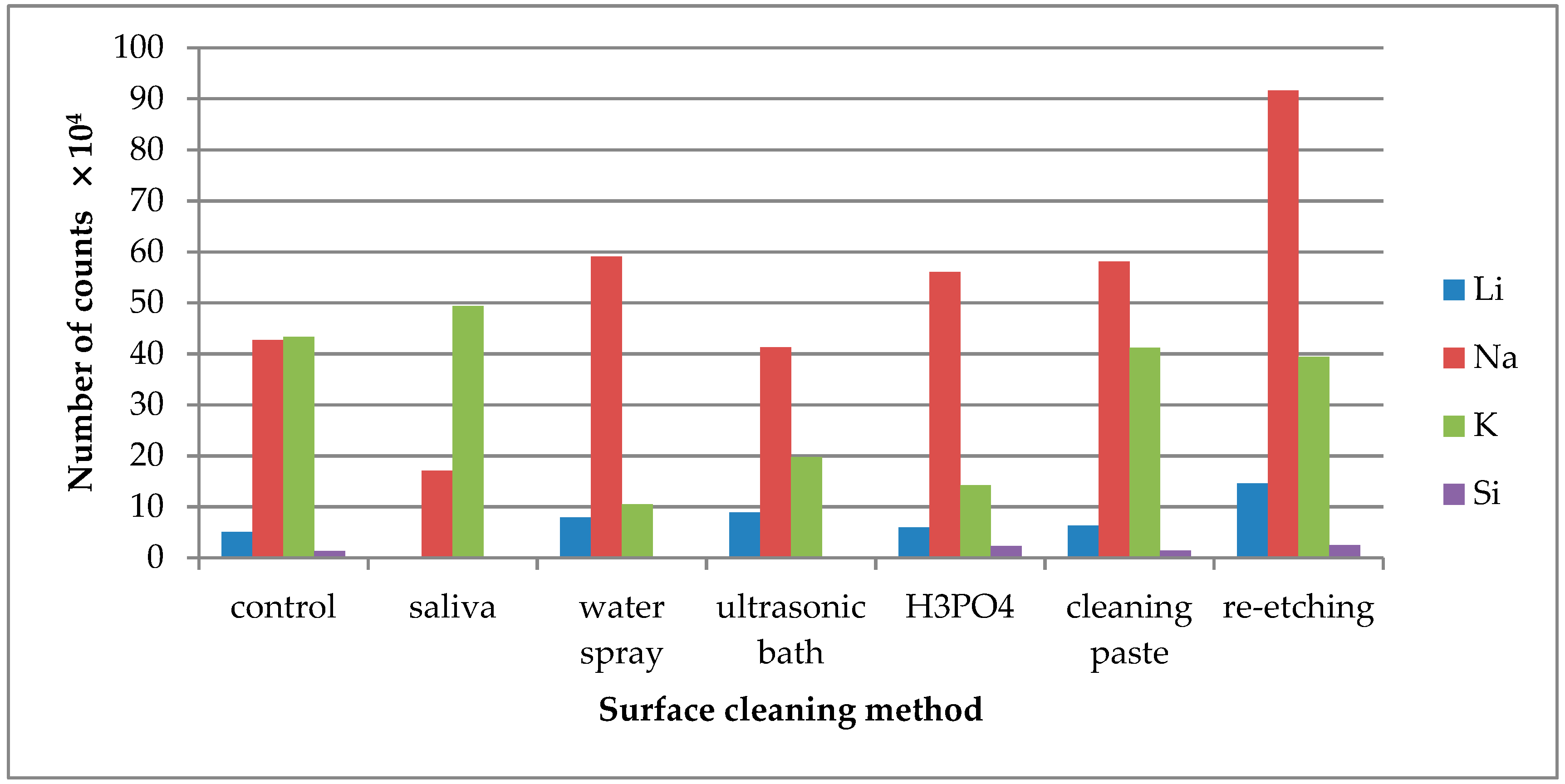

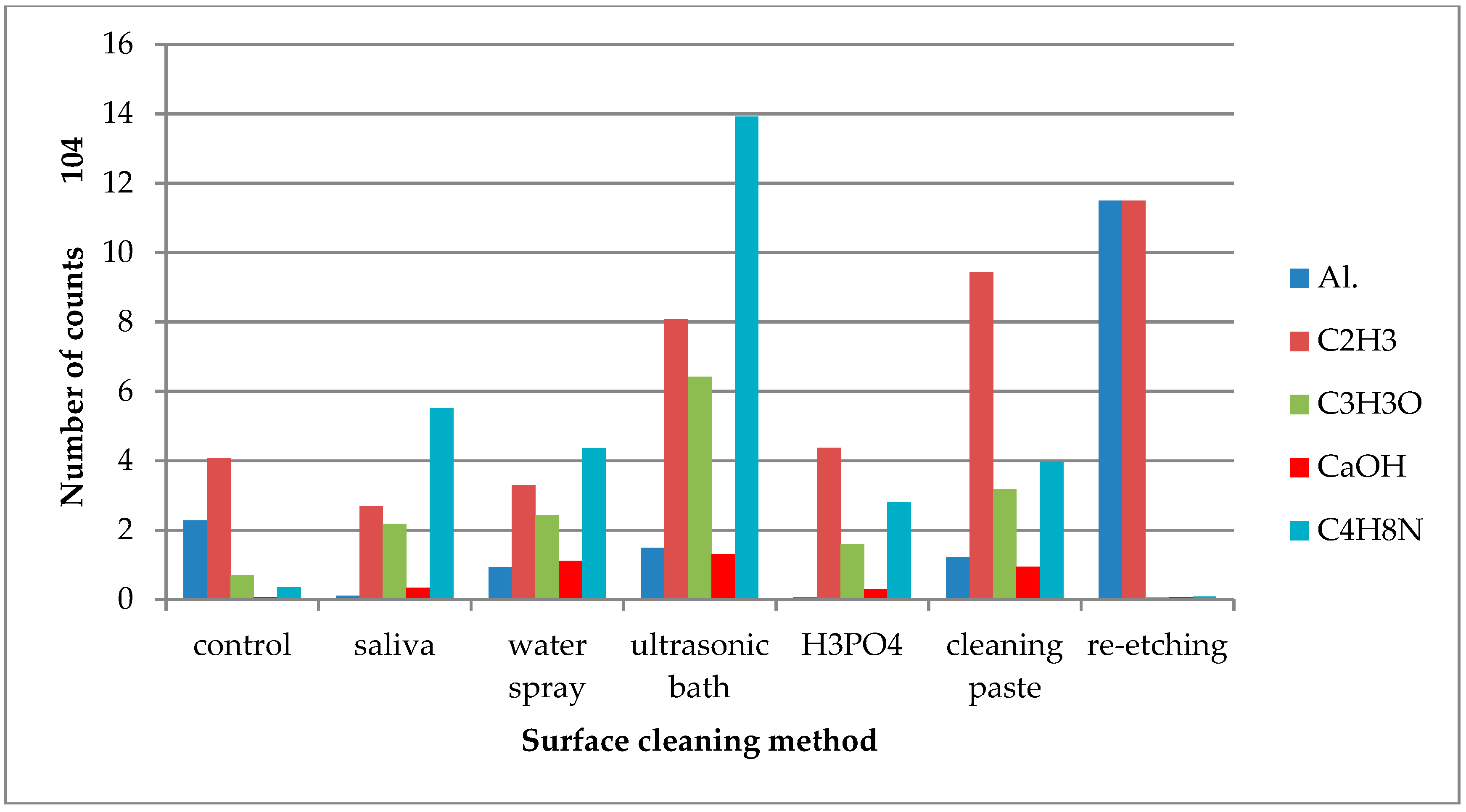
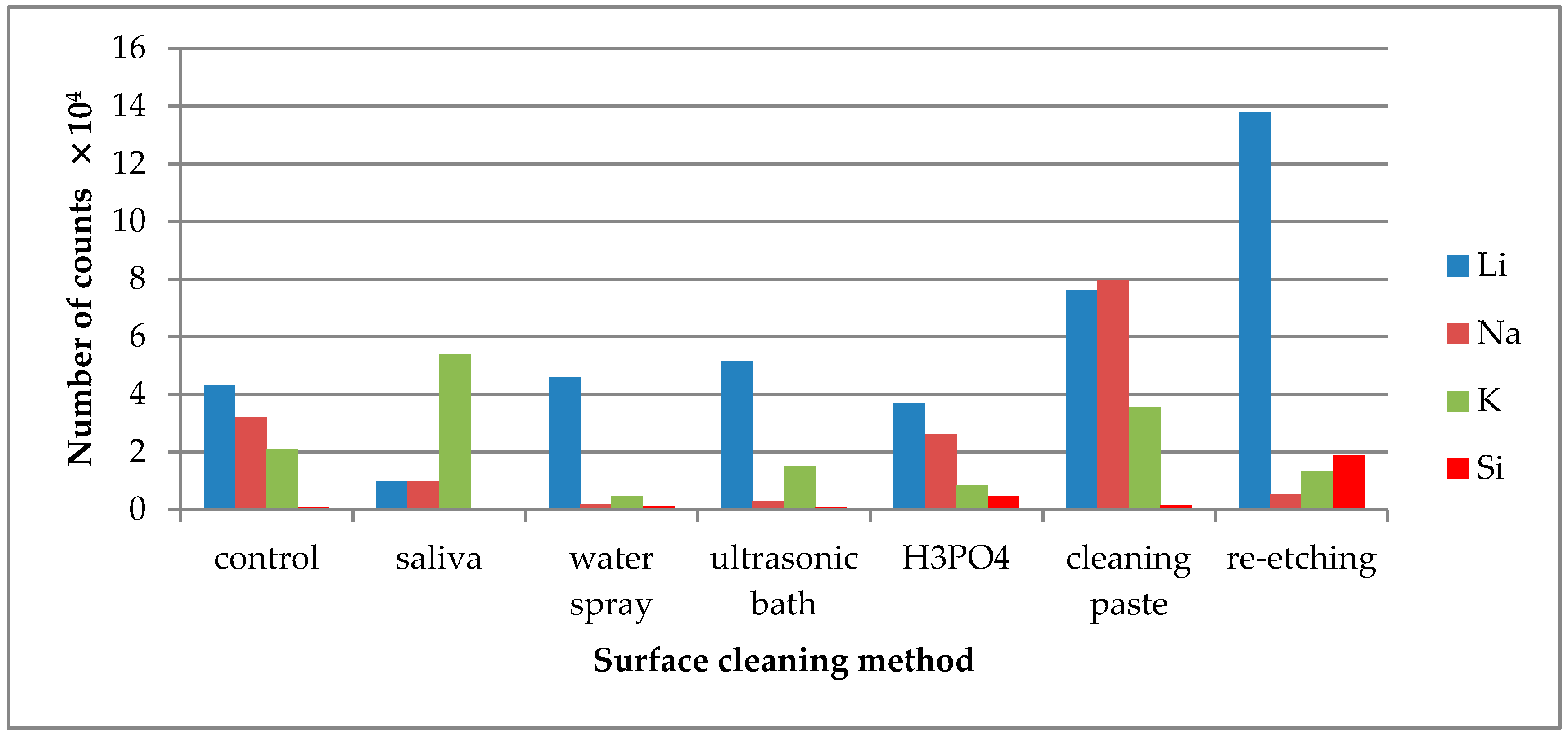

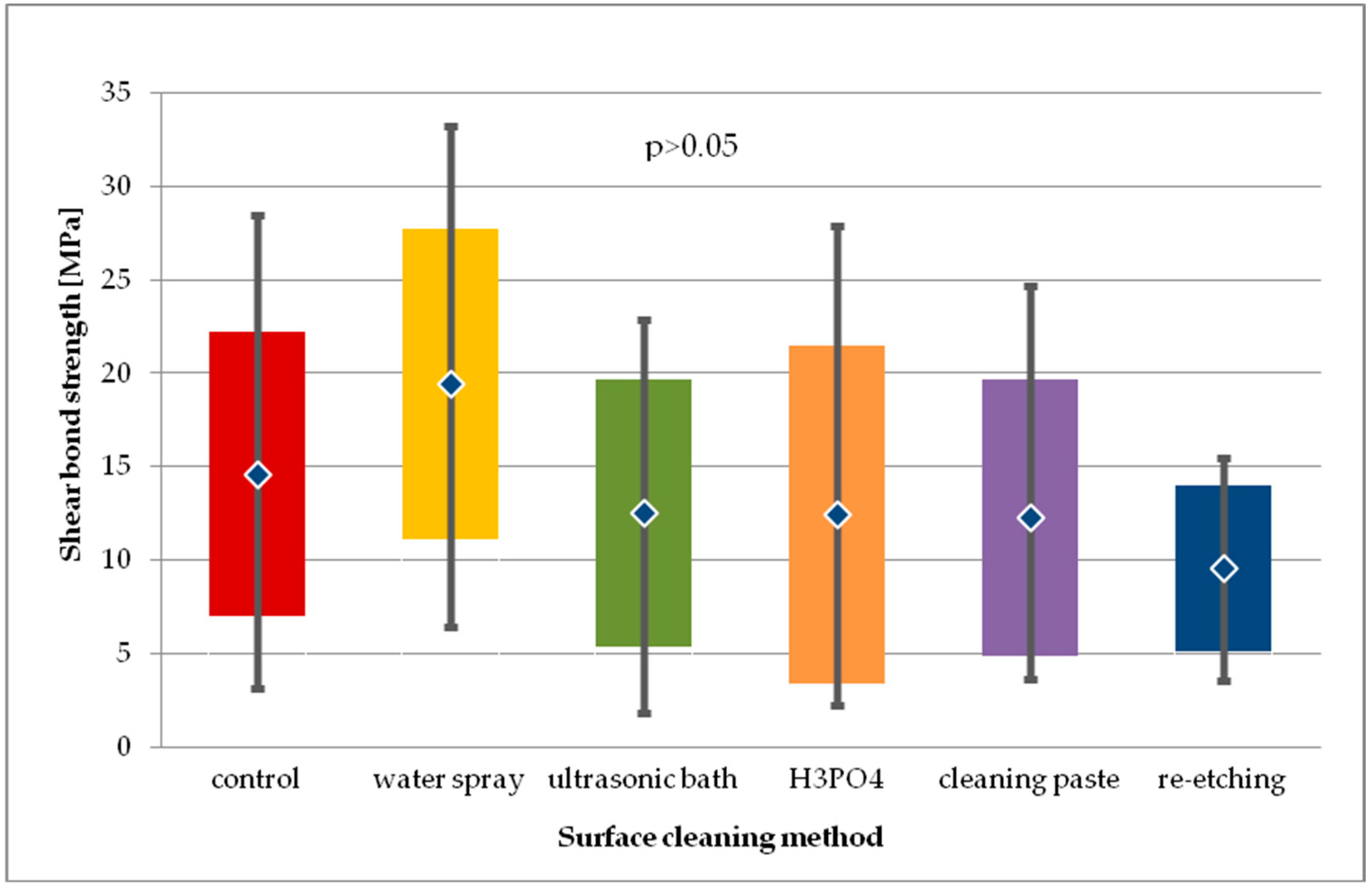

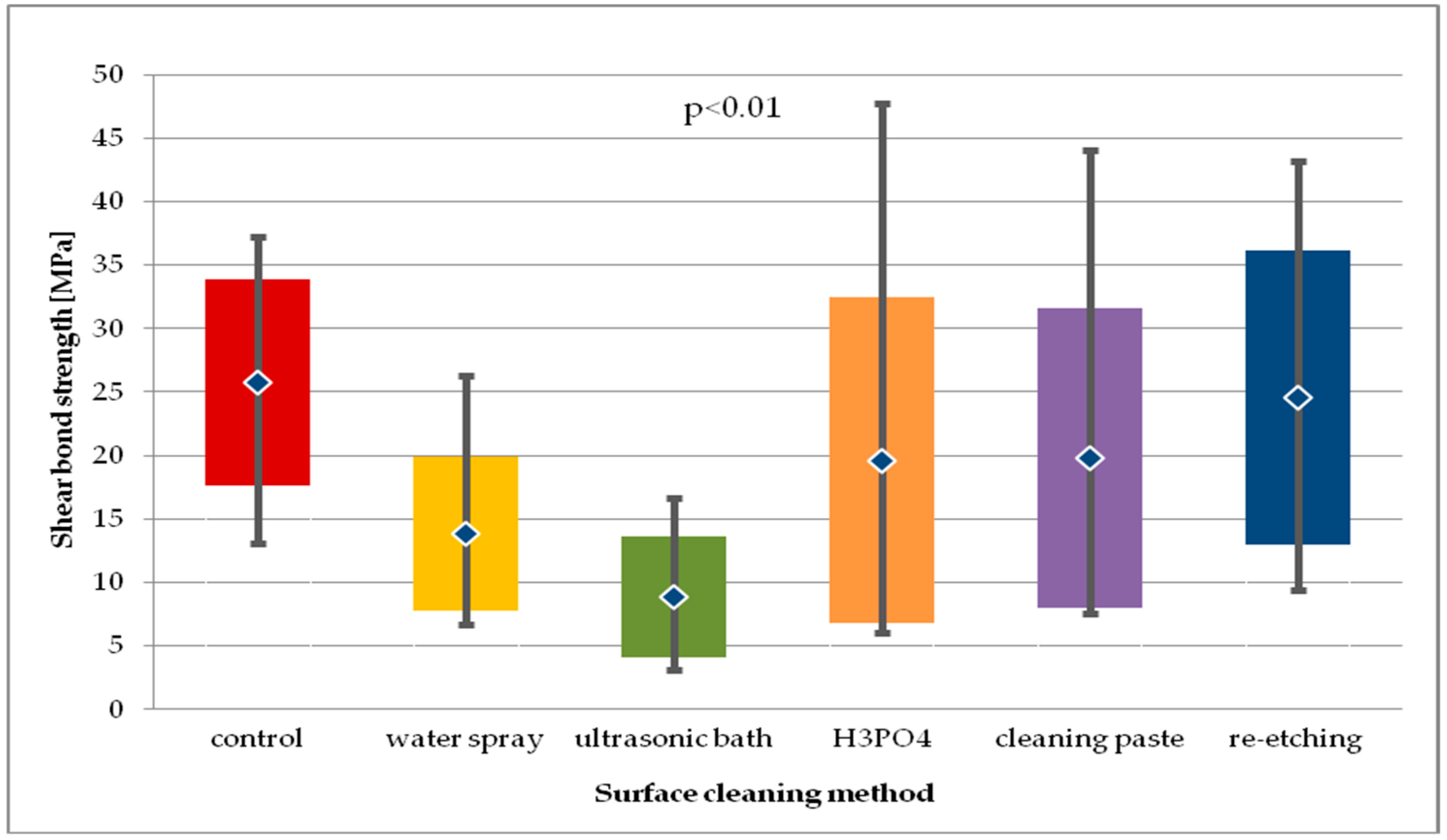

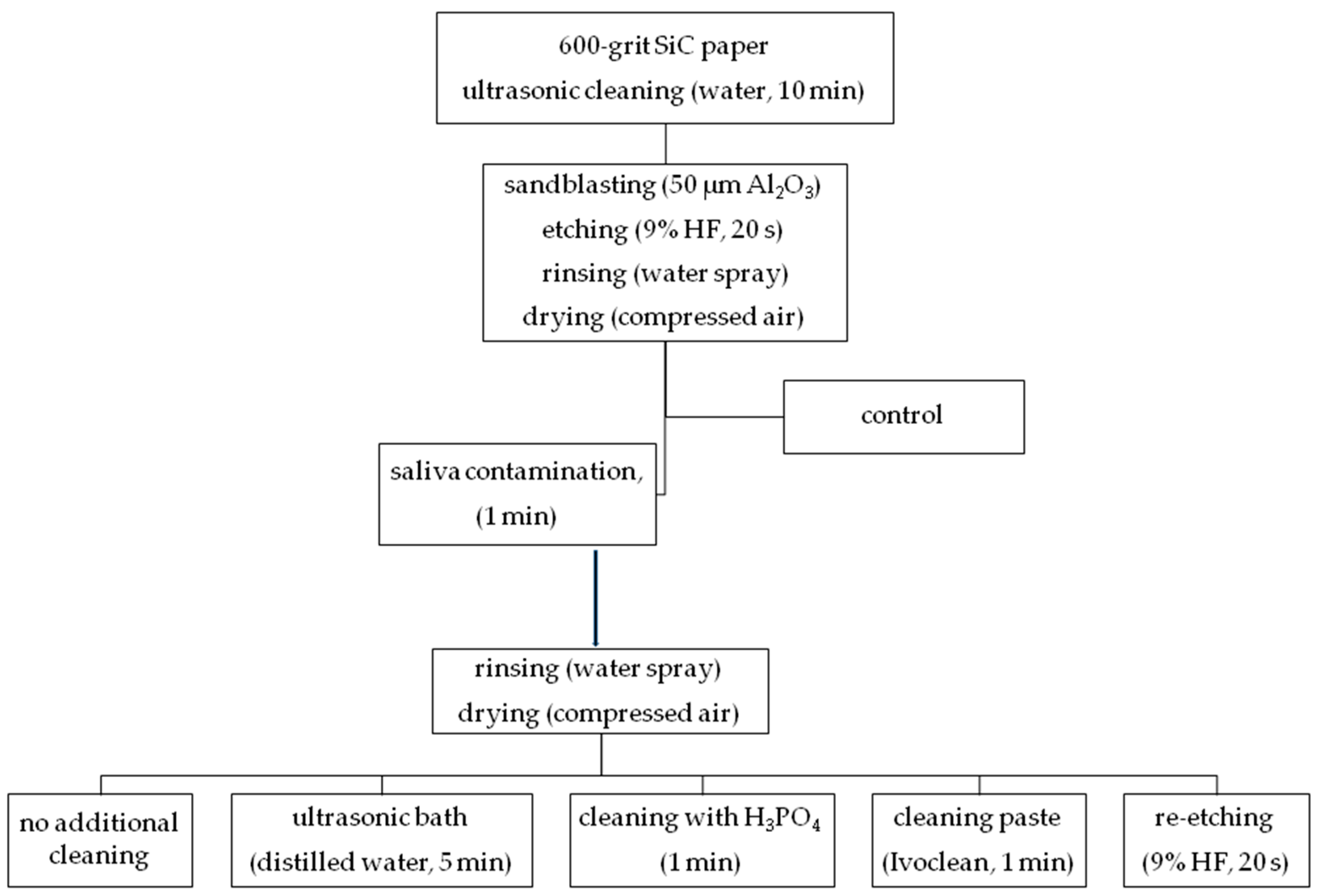
| Cleaning Method | Storage Conditions | |
|---|---|---|
| 24 h | Thermocycling | |
| control | 14.59 (±7.63)A | 5.46 (±5.24)A |
| water spray | 19.39 (±8.29)Aa | 4.70 (±3.93)Aa |
| ultrasonic bath for 5 min | 12.51 (±7.15)A | 5.14 (±5.79)A |
| H3PO4 for 1 min | 12.45 (±9.03) | 5.32 (±4.03)b |
| cleaning paste for 1 min | 12.27 (±7.36)A | 3.32 (±1.44)Aac |
| re-etching (9% HF for 20 s) | 9.56 (±4.44)Aa | 2.08 (±1.48)Aabc |
| Cleaning Method | Storage Conditions | |
|---|---|---|
| 24 h | Thermocycling | |
| control | 25.72 (±8.11)a | 26.98 (±11.97)a |
| water spray | 13.82 (±6.09)ab | 19.78 (±9.81)ab |
| ultrasonic bath for 5 min | 8.88 (±4.77)acd | 8.76 (±4.49)abcde |
| H3PO4 for 1 min | 19.63 (±12.80)c | 16.92 (±9.74)ac |
| cleaning paste for 1 min | 19.84 (±11.80)d | 13.43 (±7.01)ad |
| re-etching (9% HF for 20 s) | 24.59 (±11.60)bd | 26.39 (±12.70)e |
| Material | Name/Manufacturer | Composition |
|---|---|---|
| ceramics | Avanté® Micro Crystal Porcelain/Pentron | SiO2, Al2O3, K2O, Na2O, CaO, MgO, Li2O, F, BaO, ZrO2, B2O3, ZnO, CeO2, Y2O3, TiO2, pigments (various metal oxides) |
| ceramics | IPS e.max Press/Ivoclar Vivadent, Schaan, Liechtenstein | SiO2, Li2O, K2O, MgO, ZnO, Al2O3, P2O5 and other oxides |
| ceramic etchant | Porcelain Etch/Ultradent, Schaan, Liechtenstein | 9% buffered hydrofluoric acid |
| extra-oral cleaning paste for indirect restorations | Ivoclean/Ivoclar Vivadent, Schaan, Liechtenstein | Zirconium oxide 10–15 wt%, Water 65–80 wt%, Polyethylene glycol 8–10 wt%, Sodium hydroxide ≤ 1 wt%, Pigments, additives 4–5 wt% |
| etching gel | Total Etch/Ivoclar Vivadent, Schaan, Liechtenstein | 37% orthophosphoric acid |
| universal primer | Monobond Plus/Ivoclar Vivadent, Schaan, Liechtenstein | Alcohol solution of silane methacrylate, phosphoric acid methacrylate and sulphide methacrylate |
| bonding agent | XP Bond/Dentsply, UK | PENTA, TCB, UDMA, TGDMA, HEMA, Nanofiller, Camphorquinone, Stabilizer, Tert-Butanol |
| flowable composite material | X-flow/Dentsply, UK | Multifunctional acrylate resin, Difunctional methacrylate resin, DGDMA, UV stabilizer, Ethyl-4(dimethylamino)benzoate, Camphorquinone, BHT, Strontium-alumino-sodium-fluoro-phosphor-silicate glass, Highly dispersed silicon dioxide, Iron oxide pigments, Titanium dioxide |
| condensable composite material | Spectrum TPH®3/ Dentsply, UK | Urethane modified Bis-GMA dimethacrylate resin Ethoxylated Bisphenol A Dimethacrylate 2,2′-Ethylendioxydiethyldimethacrylat |
© 2019 by the authors. Licensee MDPI, Basel, Switzerland. This article is an open access article distributed under the terms and conditions of the Creative Commons Attribution (CC BY) license (http://creativecommons.org/licenses/by/4.0/).
Share and Cite
Lapinska, B.; Rogowski, J.; Nowak, J.; Nissan, J.; Sokolowski, J.; Lukomska-Szymanska, M. Effect of Surface Cleaning Regimen on Glass Ceramic Bond Strength. Molecules 2019, 24, 389. https://doi.org/10.3390/molecules24030389
Lapinska B, Rogowski J, Nowak J, Nissan J, Sokolowski J, Lukomska-Szymanska M. Effect of Surface Cleaning Regimen on Glass Ceramic Bond Strength. Molecules. 2019; 24(3):389. https://doi.org/10.3390/molecules24030389
Chicago/Turabian StyleLapinska, Barbara, Jacek Rogowski, Joanna Nowak, Joseph Nissan, Jerzy Sokolowski, and Monika Lukomska-Szymanska. 2019. "Effect of Surface Cleaning Regimen on Glass Ceramic Bond Strength" Molecules 24, no. 3: 389. https://doi.org/10.3390/molecules24030389
APA StyleLapinska, B., Rogowski, J., Nowak, J., Nissan, J., Sokolowski, J., & Lukomska-Szymanska, M. (2019). Effect of Surface Cleaning Regimen on Glass Ceramic Bond Strength. Molecules, 24(3), 389. https://doi.org/10.3390/molecules24030389







